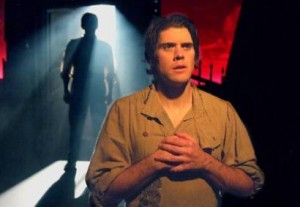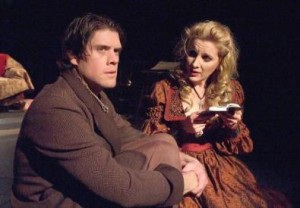RECOMMENDED
Actors Co-op is attempting pretty much the impossible—a 90 minute version
of Fyodor Dostoevsky’s Crime And Punishment, featuring a cast of three. The
adaptation, written by Marilyn Campbell and Curt Columbus, debuted
several years ago in Chicago, where it won the Jefferson Award for “Best New
Adaptation.” The playwrights deserve high marks for condensing a mammoth
novel into a one-act play without sacrificing cohesion. Its message of
redemption is particularly appropriate for the Christian-based Co-op. Director
Ken Sawyer is a master of the visual, and the production looks great.
The adaptation is told as if it were the destitute student Raskolnikov’s
dream/nightmare, allowing the action to move forward and back through
time. We see him first as he is being questioned about the crime, and through
flashbacks we gradually become aware that his initial denials are merely
attempts to hide the truth. He did indeed rob and murder pawnbroker
Alyona Ivanovna, with the pawnbroker’s sister Lizaveta becoming his second
victim when she happened upon the crime.
Raskolnikov’s motive for the killing is not just expediency. He has become
convinced that he is an extraordinary being, similar to Napoleon, who can
murder without repercussions. Coincidentally, this is the same reasoning that
allowed Richard Loeb to conceive of the murder depicted in the musical Thrill
Me and the bio-drama Dickie And Babe, both reviewed here recently. Just as
Leopold and Loeb considered themselves superior beings, so does Raskolnikov.
The Co-op production’s greatest asset is its look, sound, and feel, the real stars
of the production being Jeremy Pivnick’s superlative lighting design and
director Sawyer’s sound design, with incidental music from the film Perfume—
The Story Of A Murderer. Pivnick’s lighting, among the finest this brilliant young
talent has designed, illuminates his actors from above, behind, and below on a
mostly darkened stage, and the sound design, particularly the evocative
music, provides an emotional soundtrack to Raskolnikov’s dream. Helen
Harwell’s set design is simple but elegant, and fluid enough to represent
numerous settings. Paula Higgens’ fine costumes are noteworthy for the way
they allow for quick wardrobe/character changes.
In Campbell and Columbus’s adaptation, two of the three actors portray
several characters each, with the third actor essaying only the lead role of
Raskolnikov.
Paul Witten, who like Sawyer, has done excellent work at The Road Theater,
where both are members, portrays Porfiry Petrovich (the detective in charge
of solving the murders), the aged pawnbroker Alyona Ivanovna, and Semyon
Zakharovich Marmeladov, the drunken father of prostitute Sonya
Semyonovna Marmeladova. Interestingly, he does his best work donning a
gray wig and women’s garb as the elderly murder victim, totally disappearing
into the role.
Even better is Co-op regular Suzanne Freidline, who portrays Sonya, Lizaveta,
and Raskolnikov’s mother. The statuesque Freidline is a terrific actress whose
work in The Nerd, Tales Of Tinseltown, and A Hollywood Christmas have
demonstrated her ability to transform herself into characters totally unlike her
offstage persona. This makes her the ideal choice for this production, and she
acquits herself beautifully. Friedline understands that a period piece like this,
particularly one whose dialog comes from a translation from the Russian,
requires an elegance of speech, even when playing a woman of ill-repute like
Sonya. With her mascara lined eyes revealing Sonya’s tragic sadness all the
while her low-cut gown makes clear the profession she has fallen into, Friedline
creates a truly memorable character, distinct from the other two which she
brings to equal life.
Ben Hunter is tall, handsome, and intense as Raskolnikov, but I found him
miscast in a role which cries out for a young character actor rather than a
traditional leading man, an “Anthony Perkins role” being played by a “Rock
Hudson type.” I would like to see this actor’s work again, but in a role for which
he is better suited.
For the most part, Crime And Punishment succeeds, and the audience
response at Sunday’s Q&A was quite positive. I can recommend the
production most especially for its lush look and sound and for Friedline’s
performance(s). I look forward to seeing more of her work, as I do to seeing
more of Ken Sawyer’s considerable directorial talents.
The Crossley Theatre, 1760 N. Gower Street, Hollywood.
–Steven Stanley
March 16, 2008
Photos: Ed Krieger




 Since 2007, Steven Stanley's StageSceneLA.com has spotlighted the best in Southern California theater via reviews, interviews, and its annual StageSceneLA Scenies.
Since 2007, Steven Stanley's StageSceneLA.com has spotlighted the best in Southern California theater via reviews, interviews, and its annual StageSceneLA Scenies.







 COPYRIGHT 2024 STEVEN STANLEY :: DESIGN BY
COPYRIGHT 2024 STEVEN STANLEY :: DESIGN BY